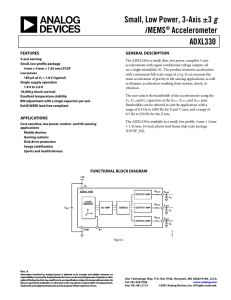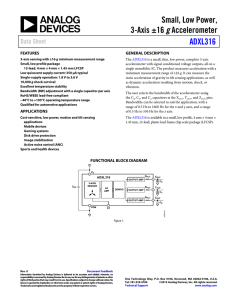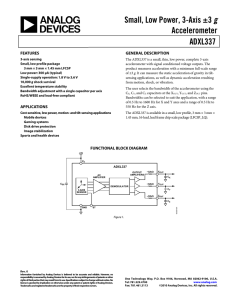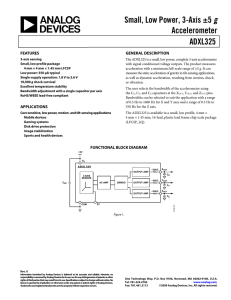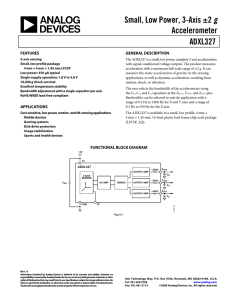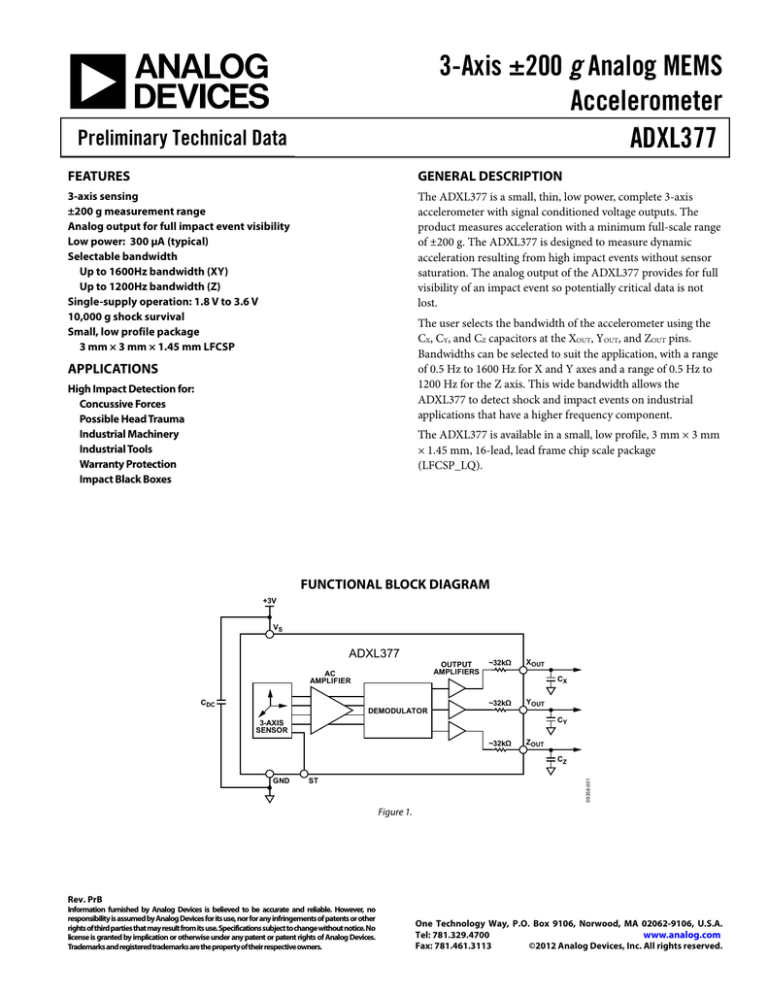
3-Axis ±200 g Analog MEMS
Accelerometer
ADXL377
Preliminary Technical Data
FEATURES
GENERAL DESCRIPTION
3-axis sensing
±200 g measurement range
Analog output for full impact event visibility
Low power: 300 μA (typical)
Selectable bandwidth
Up to 1600Hz bandwidth (XY)
Up to 1200Hz bandwidth (Z)
Single-supply operation: 1.8 V to 3.6 V
10,000 g shock survival
Small, low profile package
3 mm × 3 mm × 1.45 mm LFCSP
The ADXL377 is a small, thin, low power, complete 3-axis
accelerometer with signal conditioned voltage outputs. The
product measures acceleration with a minimum full-scale range
of ±200 g. The ADXL377 is designed to measure dynamic
acceleration resulting from high impact events without sensor
saturation. The analog output of the ADXL377 provides for full
visibility of an impact event so potentially critical data is not
lost.
The user selects the bandwidth of the accelerometer using the
CX, CY, and CZ capacitors at the XOUT, YOUT, and ZOUT pins.
Bandwidths can be selected to suit the application, with a range
of 0.5 Hz to 1600 Hz for X and Y axes and a range of 0.5 Hz to
1200 Hz for the Z axis. This wide bandwidth allows the
ADXL377 to detect shock and impact events on industrial
applications that have a higher frequency component.
APPLICATIONS
High Impact Detection for:
Concussive Forces
Possible Head Trauma
Industrial Machinery
Industrial Tools
Warranty Protection
Impact Black Boxes
The ADXL377 is available in a small, low profile, 3 mm × 3 mm
× 1.45 mm, 16-lead, lead frame chip scale package
(LFCSP_LQ).
FUNCTIONAL BLOCK DIAGRAM
+3V
VS
ADXL337
ADXL377
OUTPUT
AMPLIFIERS
AC
AMPLIFIER
CDC
DEMODULATOR
~32kΩ
XOUT
CX
~32kΩ
YOUT
CY
3-AXIS
SENSOR
~32kΩ
ZOUT
CZ
ST
09358-001
GND
Figure 1.
Rev. PrB
Information furnished by Analog Devices is believed to be accurate and reliable. However, no
responsibility is assumed by Analog Devices for its use, nor for any infringements of patents or other
rights of third parties that may result from its use. Specifications subject to change without notice. No
license is granted by implication or otherwise under any patent or patent rights of Analog Devices.
Trademarks and registered trademarks are the property of their respective owners.
One Technology Way, P.O. Box 9106, Norwood, MA 02062-9106, U.S.A.
Tel: 781.329.4700
www.analog.com
Fax: 781.461.3113
©2012 Analog Devices, Inc. All rights reserved.
ADXL377
Preliminary Technical Data
TABLE OF CONTENTS
Features .............................................................................................. 1 Performance ...................................................................................7 Applications ....................................................................................... 1 Applications Information .................................................................8 General Description ......................................................................... 1 Power Supply Decoupling ............................................................8 Functional Block Diagram .............................................................. 1 Setting the Bandwidth Using CX, CY, and CZ .............................8 Specifications..................................................................................... 3 Self Test ...........................................................................................8 Absolute Maximum Ratings............................................................ 4 ESD Caution .................................................................................. 4 Design Trade-Offs for Selecting Filter Characteristics: The
Noise/BW Trade-Off .....................................................................8 Pin Configuration and Function Descriptions ............................. 5 Axes of Acceleration Sensitivity ..................................................9 Typical Performance Characteristics ............................................. 6 Layout and Design Recommendations ................................... 10 Theory of Operation ........................................................................ 7 Outline Dimensions ....................................................................... 11 Mechanical Sensor........................................................................ 7 Rev. PrB | Page 2 of 13
Preliminary Technical Data
ADXL377
SPECIFICATIONS
TA = 25°C, VS = 3 V, CX = CY = CZ = 0.1 μF, acceleration = 0 g, unless otherwise noted. All minimum and maximum specifications are
guaranteed. Typical specifications are not guaranteed.
Table 1.
Parameter
SENSOR INPUT
Measurement Range
Nonlinearity
Package Alignment Error
Interaxis Alignment Error
Cross-Axis Sensitivity1
SENSITIVITY (RATIOMETRIC)2
Sensitivity at XOUT, YOUT, ZOUT
Sensitivity Change Due to Temperature3
0 g BIAS LEVEL (RATIOMETRIC)
0 g Voltage at XOUT, YOUT, ZOUT
0 g Offset vs. Temperature XOUT, YOUT
0 g Offset vs. Temperature ZOUT
NOISE PERFORMANCE
Noise Density XOUT, YOUT
Noise Density ZOUT
FREQUENCY RESPONSE4
Bandwidth XOUT, YOUT5
Bandwidth ZOUT5
RFILT Tolerance
Sensor Resonant Frequency
SELF TEST6
Logic Input Low
Logic Input High
ST Actuation Current
Output Change at XOUT
Output Change at YOUT
Output Change at ZOUT
OUTPUT AMPLIFIER
Output Swing Low
Output Swing High
POWER SUPPLY
Operating Voltage Range7
Supply Current
Turn-On Time8
TEMPERATURE
Operating Temperature Range
Test Conditions/Comments
Each axis
Min
Typ
Max
g
%
Degrees
Degrees
%
±200
±0.3
±1
±0.1
±1
% of full scale
Unit
Each axis
VS = 3 V
VS = 3 V
5.8
6.5
±0.01
7.2
mV/g
%/°C
VS = 3 V, 25oC
1.4
1.5
±11
±15
1.6
V
mg/°C
mg/°C
2.4
3.6
mg/√Hz rms
mg/√Hz rms
1600
1200
32 ± 15%
16.5
Hz
Hz
kΩ
kHz
Self test 0 to 1
Self test 0 to 1
Self test 0 to 1
0.6
2.4
60
- 6.5
6.5
11.5
V
V
μA
mV
mV
mV
No load
No load
0.1
2.8
V
V
1 nF external filter
1 nF external filter
1.8
VS = 3 V
1nF external filter
−40
1
3.0
300
1
3.6
V
μA
ms
+85
°C
Defined as coupling between any two axes.
Sensitivity is essentially ratiometric to VS.
Defined as the output change from ambient-to-maximum temperature or ambient-to-minimum temperature.
4
Actual frequency response controlled by user-supplied external filter capacitors (CX, CY, CZ).
5
Bandwidth with external capacitors = 1/(2 × π × 32 kΩ × C). For CX, CY = 0.003 μF, bandwidth = 1.6 kHz. For CZ = 0.01 μF, bandwidth = 500 Hz. For CX, CY, CZ = 10 μF,
bandwidth = 0.5 Hz.
6
Self test response changes cubically with VS.
7
Tested at 3.0 V and guaranteed by design only (not tested) to work over the full range from 1.8 V to 3.6 V.
8
Turn-on time is dependent on CX, CY, CZ and is approximately 160 × (CX or CY or CZ) + 1, where CX, CY, and CZ are in μF and the resulting turn-on time is in ms.
2
3
Rev. PrB | Page 3 of 13
ADXL377
Preliminary Technical Data
ABSOLUTE MAXIMUM RATINGS
Table 2.
Parameter
Acceleration (Any Axis, Unpowered)
Acceleration (Any Axis, Powered)
VS
All Other Pins
Output Short-Circuit Duration
(Any Pin to Common)
Temperature Range (Powered)
Temperature Range (Storage)
Rating
10,000 g
10,000 g
−0.3 V to +3.6 V
(GND − 0.3 V) to (VS + 0.3 V)
Indefinite
−55°C to +125°C
−65°C to +150°C
Stresses above those listed under Absolute Maximum Ratings
may cause permanent damage to the device. This is a stress
rating only; functional operation of the device at these or any
other conditions above those indicated in the operational
section of this specification is not implied. Exposure to absolute
maximum rating conditions for extended periods may affect
device reliability.
ESD CAUTION
Rev. PrB | Page 4 of 13
Preliminary Technical Data
ADXL377
1
ST
2
VS
VS
NC
16
15
14
13
ADXL377
ADXL337
TOP VIEW
(Not to Scale)
12
NC
11
NC
10
NC
9
NC
+Y
+X
5
6
7
8
NC
4
GND
YOUT
+Z
GND
3
XOUT
RES
09358-003
RES
ZOUT
PIN CONFIGURATION AND FUNCTION DESCRIPTIONS
NOTES
1. NC = NO CONNECT.
2. EXPOSED PAD IS NOT INTERNALLY
CONNECTED BUT SHOULD BE SOLDERED
FOR MECHANICAL INTEGRITY.
Figure 2. Pin Configuration
Table 3. Pin Function Descriptions
Pin No.
1, 3
2
4
5
6, 7
8 to 13
14
15
16
Mnemonic
RES
ST
YOUT
XOUT
GND
NC
VS
VS
ZOUT
EPAD
Description
Reserved. This pin must be connected to GND or left open.
Self Test.
Y Channel Output.
X Channel Output.
Must be connected to ground.
Not internally connected.
Supply Voltage (3.0 V typical).
Supply Voltage (3.0 V typical).
Z Channel Output.
Exposed Pad. Not internally connected but should be soldered for mechanical integrity.
Rev. PrB | Page 5 of 13
ADXL377
Preliminary Technical Data
TYPICAL PERFORMANCE CHARACTERISTICS
Normalized Magnitude
1.2
1
Z Axis
0.8
X, Y Axes
0.6
0.4
0.2
0
10
100
Frequency (Hz)
1000
Rev. PrB | Page 6 of 13
Preliminary Technical Data
ADXL377
THEORY OF OPERATION
The ADXL377 is a complete 3-axis acceleration measurement
system. The ADXL377 has a measurement range of ±200 g
minimum. It contains a polysilicon surface micromachined sensor
and signal conditioning circuitry to implement an open-loop
acceleration measurement architecture. The output signals are
analog voltages that are proportional to acceleration. The
accelerometer can measure the static acceleration of gravity in tiltsensing applications as well as dynamic acceleration resulting
from motion, shock, or vibration. The accelerometer is
designed to measure dynamic acceleration resulting from high
impact events without output saturation.
The sensor is a polysilicon surface micromachined structure
built on top of a silicon wafer. Polysilicon springs suspend the
structure over the surface of the wafer and provide a resistance
against acceleration forces. Deflection of the structure is measured
using a differential capacitor that consists of independent fixed
plates and plates attached to the moving mass. The fixed plates
are driven by 180° out-of-phase square waves. Acceleration deflects
the moving mass and unbalances the differential capacitor resulting
in a sensor output whose amplitude is proportional to acceleration.
Phase-sensitive demodulation techniques are then used to
determine the magnitude and direction of the acceleration.
MECHANICAL SENSOR
The ADXL377 uses a single structure for sensing the X, Y, and Z axes.
As a result, the three axes sense directions are highly orthogonal
with little cross-axis sensitivity. Mechanical misalignment of the
sensor die to the package is the chief source of cross-axis sensitivity.
Mechanical misalignment can be calibrated out at the system level.
PERFORMANCE
Rather than using additional temperature compensation circuitry,
innovative design techniques ensure that high performance is built
into the ADXL377. As a result, there is neither quantization error
nor nonmonotonic behavior, and temperature hysteresis is very low
(typically less than 30 mg over the −25°C to +85°C temperature
range).
The demodulator output is amplified and brought off chip
through a 32 kΩ resistor. The user then sets the signal bandwidth
(BW) of the device by adding a capacitor. This filtering improves
measurement resolution and helps prevent aliasing.
Rev. PrB | Page 7 of 13
ADXL377
Preliminary Technical Data
APPLICATIONS INFORMATION
POWER SUPPLY DECOUPLING
For most applications, a single 0.1 μF capacitor, CDC, placed
close to the ADXL377 supply pins adequately decouples the
accelerometer from noise on the power supply. However, in
applications where noise is present at the 50 kHz internal clock
frequency (or any harmonic thereof), additional care in power
supply bypassing is required because this noise can cause errors
in acceleration measurement. If additional decoupling is needed, a
100 Ω (or smaller) resistor or ferrite bead can be inserted in the
supply line. Additionally, a larger bulk bypass capacitor (1 μF or
greater) can be added in parallel to CDC. Ensure that the connection
from the ADXL377 ground to the power supply ground is low
impedance because noise transmitted through ground has a
similar effect as noise transmitted through VS.
SETTING THE BANDWIDTH USING CX, CY, AND CZ
The ADXL377 has provisions for band limiting the XOUT, YOUT,
and ZOUT pins. Capacitors must be added at these pins to implement
low-pass filtering for antialiasing and noise reduction. The
equation for the 3 dB bandwidth is
f−3 dB = 1/(2π(32 kΩ) × C(X, Y, Z))
DESIGN TRADE-OFFS FOR SELECTING FILTER
CHARACTERISTICS: THE NOISE/BW TRADE-OFF
The selected accelerometer bandwidth ultimately determines
the measurement resolution (smallest detectable acceleration).
Filtering can be used to lower the noise floor to improve the
resolution of the accelerometer. Resolution is dependent on the
analog filter bandwidth at XOUT, YOUT, and ZOUT.
The output of the ADXL377 has a typical bandwidth of greater
than 500 Hz. The user must filter the signal at this point to limit
aliasing errors. The analog bandwidth must be no more than half
the analog-to-digital sampling frequency to minimize aliasing.
The analog bandwidth can be decreased further to reduce noise
and improve resolution.
The ADXL377 noise has the characteristics of white Gaussian
noise, which contributes equally at all frequencies and is described
in terms of μg/√Hz (the noise is proportional to the square root
of the accelerometer bandwidth). The user should limit bandwidth
to the lowest frequency needed by the application to maximize
the resolution and dynamic range of the accelerometer.
With the single-pole, roll-off characteristic, the typical noise of
the ADXL377 is determined by
or more simply
rms Noise = Noise Density × ( BW 1.6 )
f–3 dB = 5 μF/C(X, Y, Z)
The tolerance of the internal resistor (RFILT) typically varies as
much as ±15% of its nominal value (32 kΩ), and the bandwidth
varies accordingly. A minimum capacitance of 1000 pF for CX,
CY, and CZ is recommended in all cases.
It is often useful to know the peak value of the noise. Peak-to-peak
noise can only be estimated by statistical methods. Table 5 is useful
for estimating the probabilities of exceeding various peak values,
given the rms value.
Table 4. Filter Capacitor Selection, CX, CY, and CZ
Table 5. Estimation of Peak-to-Peak Noise
Bandwidth (Hz)
50
100
200
500
1000
1600
Peak-to-Peak Value
2 × rms
4 × rms
6 × rms
8 × rms
Capacitor (μF)
0.10
0.05
0.025
0.01
0.005
0.003
SELF TEST
The ST pin controls the self test feature. When this pin is set to
VS, an electrostatic force is exerted on the accelerometer beam.
The resulting movement of the beam allows the user to test if
the accelerometer is functional. The typical change in output is
−1.08 g (corresponding to −6.5 mV) in the X-axis, +1.08 g (or
+6.5 mV) on the Y-axis, and +1.83 g (or +11.5 mV) on the
Z-axis. This ST pin can be left open circuit or connected to
common (GND) in normal use.
Never expose the ST pin to voltages greater than VS + 0.3 V. If
this cannot be guaranteed due to the system design (for instance, if
there are multiple supply voltages), then a low VF clamping
diode between ST and VS is recommended.
Rev. PrB | Page 8 of 13
Percent of Time that Noise Exceeds
Nominal Peak-to-Peak Value
32
4.6
0.27
0.006
Preliminary Technical Data
ADXL377
AXES OF ACCELERATION SENSITIVITY
The axes of sensitivity for the accelerometer are shown in Figure 3,
and Figure 4 shows the output response when the accelerometer is
oriented parallel to each of these axes.
AZ
AY
AX
09358-030
TOP
Figure 3. Axes of Acceleration Sensitivity, Corresponding Output Voltage
Increases When Accelerated Along the Sensitive Axis
XOUT = –1g
YOUT = 0g
ZOUT = 0g
TOP
GRAVITY
TOP
TOP
XOUT = 0g
YOUT = –1g
ZOUT = 0g
TOP
XOUT = 1g
YOUT = 0g
ZOUT = 0g
TOP
XOUT = 0g
YOUT = 0g
ZOUT = 1g
Figure 4. Output Response vs. Orientation to Gravity
Rev. PrB | Page 9 of 13
XOUT = 0g
YOUT = 0g
ZOUT = –1g
09358-031
XOUT = 0g
YOUT = 1g
ZOUT = 0g
ADXL377
Preliminary Technical Data
LAYOUT AND DESIGN RECOMMENDATIONS
The recommended soldering profile is shown in Figure 5 followed by a description of the profile features in Table 6. The recommended
PCB layout or solder land drawing is shown in Figure 6.
CRITICAL ZONE
TL TO TP
tP
TP
tL
TSMAX
TSMIN
tS
RAMP-DOWN
PREHEAT
09358-002
TEMPERATURE
RAMP-UP
TL
t25°C
TIME
Figure 5. Recommended Soldering Profile
Table 6. Recommended Soldering Profile
Profile Feature
Average Ramp Rate (TL to TP)
Preheat
Minimum Temperature (TSMIN)
Maximum Temperature (TSMAX)
Time (TSMIN to TSMAX), tS
TSMAX to TL
Ramp-Up Rate
Time Maintained Above Liquidous (TL)
Liquidous Temperature (TL)
Time (tL)
Peak Temperature (TP)
Time within 5°C of Actual Peak Temperature (tP)
Ramp-Down Rate
Time 25°C to Peak Temperature (t25°C)
0.40
MAX
Sn63/Pb37
3°C/sec maximum
Pb-Free
3°C/sec maximum
100°C
150°C
60 sec to 120 sec
150°C
200°C
60 sec to 180 sec
3°C/sec maximum
3°C/sec maximum
183°C
60 sec to 150 sec
240°C + 0°C/−5°C
10 sec to 30 sec
6°C/sec maximum
6 minutes maximum
217°C
60 sec to 150 sec
260°C + 0°C/−5°C
20 sec to 40 sec
6°C/sec maximum
8 minutes maximum
3
0.50
0.25
0.25
MAX
0.50
3
1.60
0.25
CENTER PAD IS NOT
INTERNALLY CONNECTED
BUT SHOULD BE SOLDERED
FOR MECHANICAL INTEGRITY
DIMENSIONS SHOWN IN MILLIMETERS
Figure 6. Recommended PCB Layout
Rev. PrB | Page 10 of 13
09358-004
1.60
Preliminary Technical Data
ADXL377
OUTLINE DIMENSIONS
0.30
0.25
0.18
0.50
BSC
13
PIN 1
INDICATOR
16
1
12
1.70
1.60 SQ
1.50
EXPOSED
PAD
9
TOP VIEW
1.50
1.45
1.40
SEATING
PLANE
0.45
0.40
0.35
4
8
5
BOTTOM VIEW
0.05 MAX
0.02 NOM
COPLANARITY
0.08
0.152 REF
0.20 MIN
FOR PROPER CONNECTION OF
THE EXPOSED PAD, REFER TO
THE PIN CONFIGURATION AND
FUNCTION DESCRIPTIONS
SECTION OF THIS DATA SHEET.
Figure 7. 16-Lead Lead Frame Chip Scale Package [LFCSP_LQ]
3 mm × 3 mm Body, Thick Quad
(CP-16-28)
Dimensions shown in millimeters
Rev. PrB | Page 11 of 13
04-27-2010-A
PIN 1
INDICATOR
3.10
3.00 SQ
2.90
ADXL377
Preliminary Technical Data
NOTES
Rev. PrB | Page 12 of 13
Preliminary Technical Data
ADXL377
NOTES
©2012 Analog Devices, Inc. All rights reserved. Trademarks and
registered trademarks are the property of their respective owners.
PR10765-0-5/12(PrB)
Rev. PrB | Page 13 of 13


